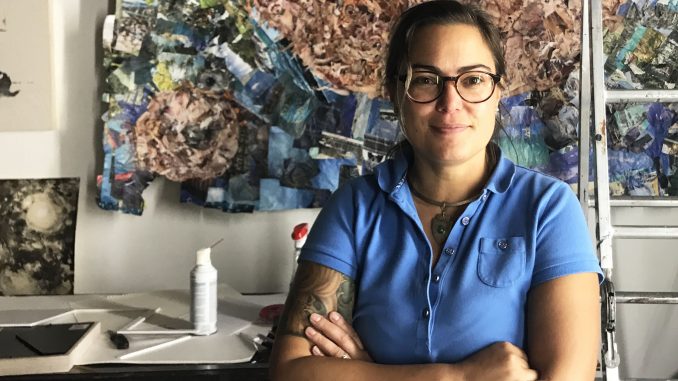
The walls of artist Ana Vizcarra Rankin’s art studio in Kensington are covered in a collage of world maps and stars, each made from layers of graphite, oil paint and even coffee. Some are finely detailed in cool pastels, while others burst with contrasting colors like cobalt blue and bright yellow.
Vizcarra Rankin, a Uruguayan-American artist and 2010 art history alumna, has her first solo museum show, “Time/Scale,” at the Brandywine River Museum of Art in Chadds Ford, Pennsylvania. The show runs through Nov. 5.
“It is my first time having an entire museum gallery to fill up, all for me,” she said. “It’s a dream come true.
Through large paintings and hand-made collages of constellations and world maps, “Time/Scale” explores space and time and their connection to humanity, globalization, migration and scientific exploration, according to Philadelphia Contemporary, which curated the show. Philadelphia Contemporary is a nonprofit that collaborates with museums and artists in the city to present contemporary art.
Vizcarra Rankin’s first solo museum show comes after 20 years of artmaking and nearly 50 solo shows in other art spaces.
Despite Vizcarra Rankin’s recent success, her career has not been without difficulties. She has faced continuous discouragement.
In her first show, Vizcarra Rankin displayed her art in the bar where she worked. Since she wore a uniform, it wasn’t obvious that she was the artist.
“This person kept talking about how interested he was in this ‘dude’s work,’” she said. “When he saw me, he was suddenly [disinterested]…the tiny brown woman making big art about science, it’s tough.”
She has also gone through financial difficulties in her art career.
“I’ve had to [bartend] and sell real estate just so I could have 10 hours a week to paint, which was like, late night on the weekends,” Vizcarra Rankin said. “By late night, I mean four in the morning until 9 a.m.”
Ashley West, an art history professor who was a mentor to Vizcarra Rankin during her time at Temple, said she’s a “very self-aware” artist.
“She knows how and where her work fits into the history of art, how her work is in dialogue with artists living and dead, across Europe, across Latin America,” West said. “The whole history of art comes out subtly in the layers of her work.”
Vizcarra Rankin’s maps are made after extensive research on topics like climate change and migration, with the aid of local libraries and online access to university libraries, including Paley Library. Vizcarra Rankin said the information she learns is often saddening and overwhelming.
“I’m using these sort of baroque technologies,” Vizcarra Rankin said. “I work with gesso and graphite and canvas and wood, like, they’re very organic kind of noble materials, but I’m using 21st century information that’s readily available.”
In one piece, she depicts a map from the late 19th century. Antarctica is overly large with rough borders. The cartography was limited due to technology at the time, so it was difficult to determine the difference between an ice shelf and land mass.
“If you look at the way that we show Antarctica now, it has a big gouge in it,” she said. “And part of that is we now understand where the ice shelf ends and where the land mass begins, but the reality is becoming more and more like that because we are losing so much of the ice shelf.”
She added that no matter how optimistic she tries to be, the data she often uses for her work are really discouraging.
“The maps fill a niche for me of difficult things I need to think about and deal with,” she added.
To find a break from the overwhelming data, her cartographic interest led her to study star maps.
For Vizcarra Rankin, painting the stars is a way to return to peace and wonder in her art. Looking up at the stars gives her balance.
“It’s really great to just go out and take that time in the dark to just let your pupils dilate,” she said. “It’s like the most clean, wonderful, exhilarating thing, to just lay down and just look up,” she said.



Be the first to comment